
Uit het nummer ‘The WASP’ van the Doors op L.A.Woman.
‘I wanna tell you about Texas Radio and the big beat.’
Texas Radio refers to high power Mexican radio stations that blasted Texas into the 1950s. Not restricted by American regulations, said stations could have up to 150 megawatts. Morrison and Manzarek both heard Wolfman Jack on one of these Mexican stations.
‘The Negroes in the forest brightly feathered
They are saying, “Forget the night.
Live with us in forests of azure.
Out here on the perimeter there are no stars
Out here we is stoned – immaculate.’
U denkt begrijpelijkerwijs negers in Midden Amerika, ten tijde van de Mayacultuur?
Het houdt verband met de ‘Giant Stone Heads’ van La Venta. Olmec in Mexico. Dus ‘Out here we is stoned-immaculate’. Van steen, bedwelmd als in ‘stoned’ en perfect.
(Uit het stuk ‘Pharao Pacal van Palenque en Jim Morrisson’ onder Muziek‘)

De betekenis ontsnapt aan het rationeel vermogen.
Dichtkunst.
Alle kolossale hoofden op een rij.
Alle ‘Colossal Heads’ op een rij:
http://www.latinamericanstudies.org/olmec-colossal-heads-1.htm
Beeldhouwen is een ander talent. Wie portretteerde deze Olmec figuur in één stijl?
Is het één en dezelfde geportretteerde?
Bovenste foto’s Monument 1 Colossal Head.
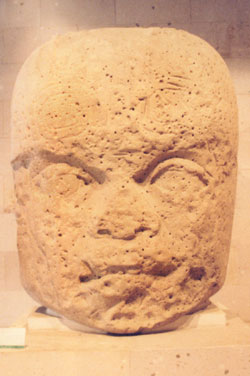
Is het slijtage of bewuste vernieling? Colossal head nr. 7 San Lorenzo. In I-photo.
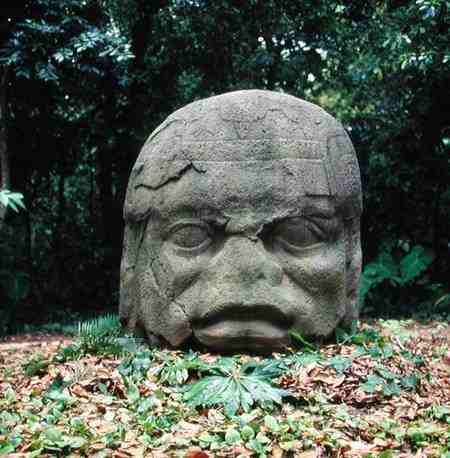
Olmec – Colossal Head 4, Pre-Classic Period, La Venta. Slijtage, bewust beschadigd of onaf?
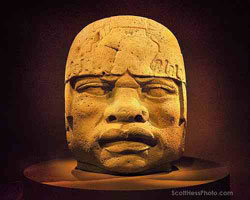
Colossal Head 5, the massive stone carving of an Olmec ruler from the first site of San Lorenzo made between 1200 and 900 BCE. It was 1.86m by 1.44m by 1.25m.
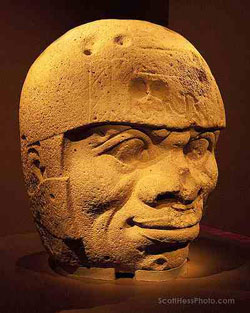
Colossal Head 9 La Venta(?). Smiling face.
Achtergrond informatie Olmec cultuur Wikipedia;
La Venta is a pre-Columbian archaeological site of the Olmec civilization located in the present-day Mexican state of Tabasco. Some of the artifacts have been moved to the museum “Parque – Museo de La Venta”, which is in Villahermosa, the capital of Tabasco.
Certainly the most famous of the La Venta monumental artifacts are the four colossal heads. Seventeen colossal heads have been unearthed in the Olmec area, four of them at La Venta, officially named Monuments 1 through 4.
Three of the heads—Monuments 2, 3, & 4—were found roughly 150 meters north of Complex A, which is itself just north of the Great Pyramid. These heads were in a slightly irregular row, facing north. The other colossal head—Monument 1 (shown at left) — is a few dozen meters south of the Great Pyramid.
The La Venta heads are thought to have been carved by 700 BCE, but possibly as early as 850 BCE, while the San Lorenzo heads are credited to an earlier period. The colossal heads can measure up to 9 ft 4 in. in height and weigh several tons. The sheer size of the stones causes a great deal of speculation on how the Olmec were able to move them. The major basalt quarry for the colossal heads at La Venta was found at Cerro Cintepec in the Tuxtla Mountains, over 80 km away.[12]
Each of the heads wears headgear reminiscent of 1920s-style American football helmets, although each is unique in its decoration. These helmets probably served as protection in war and in the ceremonial Mesoamerican ballgame played throughout Mesoamerica. The consensus is that the heads likely represent mighty Olmec rulers.
Het lijkt duidelijk één en dezelfde persoon in de Colossal Heads, wie was het?
En mogelijk slechts één meester beeldhouwer die zelfs een glimlach op het gelaat achterliet.
De massieve reeks granieten koppen doen de vraag rijzen naar hun lichamen. Hoe was de oorspronkelijke ‘display’?
De begraving van de kolossale hoofden is eveneens raadselachtig. Is het vanuit bezwering of bescherming geschiedt?
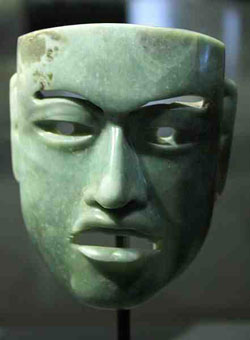
Ter vergelijking een Olmec-stijl masker in jade uit Tabasco (Mexico). Musées Royaux d’Art et d’Histoire, Brussels (Belgium).
Wikipedia:
Another type of artifact is much smaller; hardstone carvings in jade of a face in a mask form. Curators and scholars refer to “Olmec-style” face masks but, to date, no example has been recovered in an archaeologically controlled Olmec context. They have been recovered from sites of other cultures, including one deliberately deposited in the ceremonial precinct of Tenochtitlan (Mexico City). The mask would presumably have been about 2,000 years old when the Aztec buried it, suggesting such masks were valued and collected as Roman antiquities were in Europe.
Zie ook ‘Slechts één beeldhouwer in Göbekli Tepe?’ onder Ruïnes, Architectuur en Lading en ‘De beeldhouwer van Lepenski Vir’ onder Kunst.